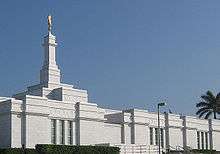Veracruz Mexico Temple
The Veracruz Mexico Temple, located in Boca del Río in the Mexican state of Veracruz, is the 93rd operating temple of The Church of Jesus Christ of Latter-day Saints (LDS Church).
| Veracruz Mexico Temple | |||||||||||||||||||||||||||||||||||||||||
|---|---|---|---|---|---|---|---|---|---|---|---|---|---|---|---|---|---|---|---|---|---|---|---|---|---|---|---|---|---|---|---|---|---|---|---|---|---|---|---|---|---|
 | |||||||||||||||||||||||||||||||||||||||||
| Number | 93 | ||||||||||||||||||||||||||||||||||||||||
| Dedicated | 9 July 2000 by Thomas S. Monson | ||||||||||||||||||||||||||||||||||||||||
| Site | 3.39 acres (1.4 hectares) | ||||||||||||||||||||||||||||||||||||||||
| Floor area | 10,700 sq ft (990 m2) | ||||||||||||||||||||||||||||||||||||||||
| Height | 71 ft (22 m) | ||||||||||||||||||||||||||||||||||||||||
| Preceded by | Mérida Mexico Temple | ||||||||||||||||||||||||||||||||||||||||
| Followed by | Baton Rouge Louisiana Temple | ||||||||||||||||||||||||||||||||||||||||
| Official website • News & images | |||||||||||||||||||||||||||||||||||||||||
| |||||||||||||||||||||||||||||||||||||||||
History
The LDS Church announced on April 14, 1999 that a temple would be built near the Mexican port city of Veracruz, Veracruz. The Veracruz temple, located in the adjacent city of Boca del Río some 10 km south of downtown Veracruz, is one of twelve LDS temples in Mexico. Previously, local members had to travel to the Mesa Arizona Temple in the United States.
The first Mormon missionaries arrived in Veracruz in 1955. The first meetinghouse was built in 1961. At the dedication of the meetinghouse nearly 700 people were in attendance even though the meetinghouse would serve not quite 400. After the dedication of the meetinghouse the missionary work in the area grew rapidly.
A groundbreaking ceremony and site dedication for the Veracruz México Temple were held on May 29, 1999, with Carl B. Pratt, of the Seventy, presiding. Around 600 people attended the ceremony. The temple site is 3.39 acres (1.37 ha), which includes a meetinghouse. The temple was open for tours to the public from June 26 through July 1, 2000. More than 10,000 people toured the temple during this time.
Thomas S. Monson, of the church's First Presidency, dedicated the Veracruz temple on July 9, 2000.[1] Four sessions were held and more than 5,000 members attended. The temple serves nine stakes, two districts, and two branches in the area.
The Veracruz México Temple has a total of 10,700 square feet (990 m2), two ordinance rooms, and two sealing rooms.[2]
In 2020, like all the church's other temples, the Veracruz Mexico Temple was closed due to the COVID-19 pandemic.[3]
See also
- Comparison of temples of The Church of Jesus Christ of Latter-day Saints
- List of temples of The Church of Jesus Christ of Latter-day Saints
- List of temples of The Church of Jesus Christ of Latter-day Saints by geographic region
- Temple architecture (Latter-day Saints)
- The Church of Jesus Christ of Latter-day Saints in Mexico
References
- "Veracruz Mexico: 'May Thy work grow and strengthen'", Church News, July 15, 2000
- "Facts and figures: Veracruz Mexico Temple", Church News, July 15, 2000
- Stack, Peggy Fletcher. "All Latter-day Saint temples to close due to coronavirus", The Salt Lake Tribune, 26 March 2020. Retrieved on 28 March 2020.
Additional reading
- "Dedication dates announced for temples in Mexico, U.S.", Church News, May 20, 2000
- Swensen, Jason (July 15, 2000), "Temple reflects generosity, beauty of Veracruz saints", Church News
External links
- Veracruz Mexico Temple Official site
- Veracruz Mexico Temple at ChurchofJesusChristTemples.org
